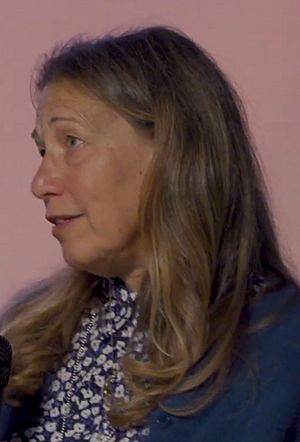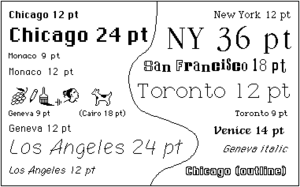Susan Kare facts for kids
Quick facts for kids
Susan Kare
|
|
|---|---|

Kare in 2019
|
|
| Born | February 5, 1954 Ithaca, New York, U.S.
|
| Education | Mount Holyoke College (BA) New York University (MA, PhD) |
| Occupation | Graphic designer |
| Known for | Contemporary American design |
|
Notable work
|
GUI design language and product launch of the Macintosh |
| Spouse(s) |
Jay Tannenbaum
(div. 2011) |
| Children | 3 |
| Relatives | Jordin Kare (brother) |
Susan Kare (born February 5, 1954) is an American artist and graphic designer. She is famous for creating the look and feel of the first Apple Macintosh computers. This included designing many of the icons and fonts (typefaces) that people saw on the screen.
Susan was one of the first employees at NeXT, a company started by Steve Jobs after he left Apple. She has also worked as a design expert for big companies like Microsoft, IBM, Sony Pictures, Facebook, and Pinterest. Today, she works at Niantic Labs. Susan Kare is known as a pioneer of pixel art and graphical user interface (GUI) design. She is celebrated as one of the most important designers in modern technology.
Contents
Early Life and Education
Susan Kare was born in Ithaca, New York. Her father was a professor, and her mother taught her counted-thread embroidery. From a young age, Susan loved drawing, painting, and crafts. Her brother was an aerospace engineer named Jordin Kare.
She finished high school in 1971. In 1975, she earned a degree in art from Mount Holyoke College with high honors. She then went on to get her master's and doctorate degrees in fine arts from New York University in 1978. Her dream was to be an artist or a teacher.
Susan Kare's Career Journey
Starting Out in Design
Susan Kare always focused on fine art. During high school summers, she worked at the Franklin Institute. There, she learned about typography, which is the art of arranging type. She gained experience by taking on many free design jobs, like making posters and brochures.
After getting her doctorate, she moved to San Francisco. She worked at the Fine Arts Museums of San Francisco as a sculptor and sometimes a curator. She later realized that while she loved making art, sculpture could be a bit lonely.
Designing for Apple
In 1982, Susan was working on a large sculpture when a friend from high school, Andy Hertzfeld, called her. He asked her to draw some icons and fonts for the new Macintosh computer. Even though she had no experience with computer graphics or pixel art, she used her art skills from mosaics and needlepoint.
Andy suggested she use a small grid notebook to draw ideas for icons. These included a scissors icon for "cut," a finger for "paste," and a paintbrush for MacPaint. She was excited to join the team and was hired in January 1983. Her business cards said "Macintosh Artist."
Susan was new to computers, but she quickly understood the Macintosh. She loved how easy it was to design on the screen. She could undo, redo, and change icons or letters instantly. She used the basic graphics tools available and helped improve the MacPaint program. Her goal was to make the Macintosh feel friendly and easy to use.
Susan's fun personality became a big part of the early Macintosh team. She even drew pixel portraits of her co-workers. She and Steve Capps made a Jolly Roger pirate flag with a rainbow Apple logo. This showed the team's rebellious spirit, following Steve Jobs' idea that "it's better to be a pirate than to join the Navy."
Susan worked closely with programmers, especially Andy Hertzfeld. She spent many hours creating graphics, getting feedback from the team. Steve Jobs himself approved her main desktop icons. She also helped promote the Macintosh before it launched in 1984.
In just one year, she designed the main visual style for the original Macintosh. This included marketing materials, many typefaces, and icons. These designs became the first visual language for the Macintosh and helped Apple lead the way in graphical user interface (GUI) computing.
She improved existing icons like the trash can and the dog-eared paper icon. She also came up with the idea of giving each document a unique icon based on the program that created it. Her designs like the Lasso, Grabber, and Paint Bucket became common tools in computing.
Some of her most famous icons include Clarus the Dogcow (seen in print settings), the Happy Mac (a smiling computer that appeared when the computer started), and the Command key symbol on Apple keyboards. She also designed the world's first digital fonts that had different spacing for each letter, like Chicago, Geneva, and Monaco. Chicago was her first font, used for menus and dialog boxes. She also created Cairo, a font made of icons, like early emojis.
Susan later became a Creative Director at Apple. She remembered how lucky she felt to be an artist working with talented engineers.
After Apple: A Design Consultant
In 1986, Susan Kare left Apple with Steve Jobs to start NeXT, Inc.. She was the Creative Director and the 10th employee. She helped Jobs hire famous designer Paul Rand to create NeXT's logo.
Susan wanted to go back to designing "bitmaps" (pixel graphics). So, she left NeXT to become an independent designer. She worked for many big companies like Microsoft, IBM, Sony Pictures, and Intel.
For Microsoft, she designed the card deck for the Windows 3.0 solitaire game. This game helped many early computer users learn how to use a mouse to drag and drop things on a screen. She also designed many icons and wallpapers for Windows 3.0. Many of her icons, like those for Notepad, stayed the same in Windows for a long time. For IBM, she created icons for their OS/2 system.
From 2006 to 2010, she designed hundreds of icons for the virtual gifts feature on Facebook. In 2007, she designed the look and feel for Chumby, an Internet-connected alarm clock.
Since 2008, the Museum of Modern Art (MoMA) in New York City has sold stationery and notebooks featuring her designs. In 2015, MoMA even bought her original sketchbooks for the Macintosh user interface.
In 2015, Susan Kare joined Pinterest as a product design lead. This was her first full-time job at a company in 30 years. As of 2025, she is a Design Architect at Niantic Labs. She also runs her own digital design business in San Francisco and sells signed art prints.
Susan Kare's Design Ideas
Susan Kare's main design rules are meaning, memorability, and clarity. She believes that good icons should be simple and easy to understand and remember. She once said, "an icon is successful if you could tell someone what it is once and they don't forget it."
She compares good icons to traffic signs: "simple symbols with few extra details, which makes them more universal." She believes there's no need to constantly update a stop sign. She always focuses on making images fit their meaning.
Her main goal with the Macintosh was to make it feel more human and friendly, giving it "a smile." She wanted to bring an artist's touch to computers, which had mostly been designed by engineers. Her Macintosh icons were inspired by many things, like art history, pirate stories, and old symbols. For example, the Command key symbol on Apple keyboards comes from an old Scandinavian symbol for a place of interest.
She was great at solving design problems with the limited technology of the 1980s. She used her art skills to create detailed pixel art even with very few pixels. For example, her original fonts were very small, but she made them look smooth by using only straight or 45-degree lines.
Today, she uses modern design software like Adobe Photoshop and Adobe Illustrator. However, she still prefers the challenge of designing with small, limited pixels.
Recognition and Impact
The Smithsonian Institution has called her designs "simple, elegant, and whimsical." In 2015, the Museum of Modern Art (MoMA) showed her original sketches. They said her fonts and icons gave the Mac "voice, personality, style, and even a sense of humor." MoMA called her "a pioneering and influential computer iconographer" whose designs are clear, memorable, and witty.
In 2018, the American Institute of Graphic Arts gave her a medal for her "whimsical charm and an independent streak." In 2019, she received the National Design Award for Lifetime Achievement. On International Women's Day in 2018, she was recognized as a technologist who helped shape the modern world.
Susan Kare is seen as a pioneer of pixel art and the graphical user interface. She has spent over three decades at the forefront of how people interact with computers.
Her work on the original Macintosh helped create the visual language for Apple's groundbreaking computers. Her most famous designs include the first digital fonts with different spacing, like Chicago, Geneva, and Monaco. Chicago was used in classic Mac OS from 1984 to 1999 and in the first four generations of the iPod. Her designs were key to making the Macintosh one of the most successful computer platforms ever.
For many years, she shared her design ideas with other big companies like Microsoft Windows, IBM OS/2, Facebook, and Pinterest.
Her icon designs have been shown in museums like the National Museum of American History and the Museum of Modern Art. Her work has a dedicated following, and large prints of her digital designs are sold.
Personal Life
Susan Kare was married to Jay Tannenbaum, and they have three sons. Their marriage ended in 2011. Her brother was aerospace engineer Jordin Kare.
See also
 In Spanish: Susan Kare para niños
In Spanish: Susan Kare para niños
- List of Apple typefaces
- Typography of Apple Inc.




